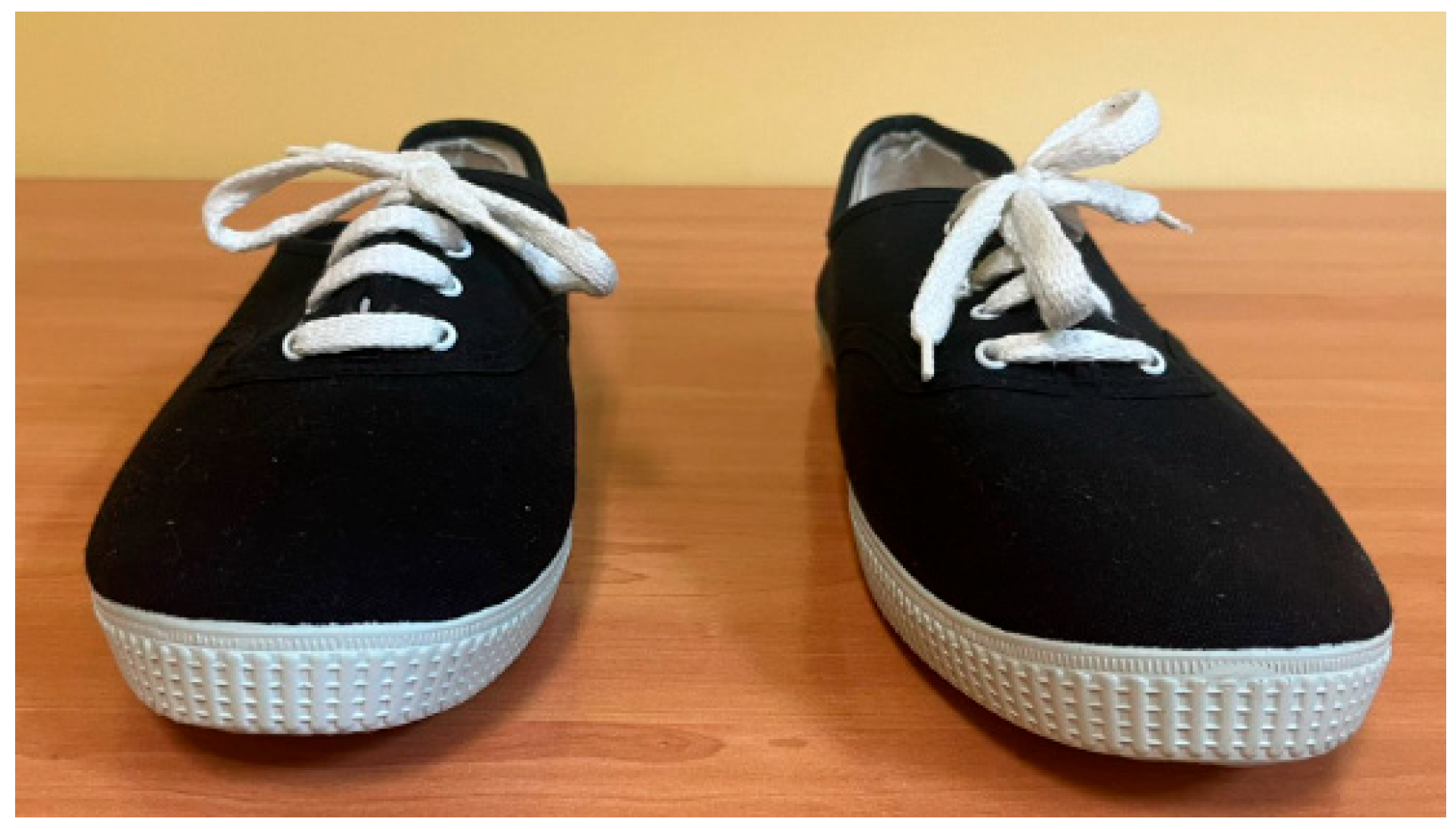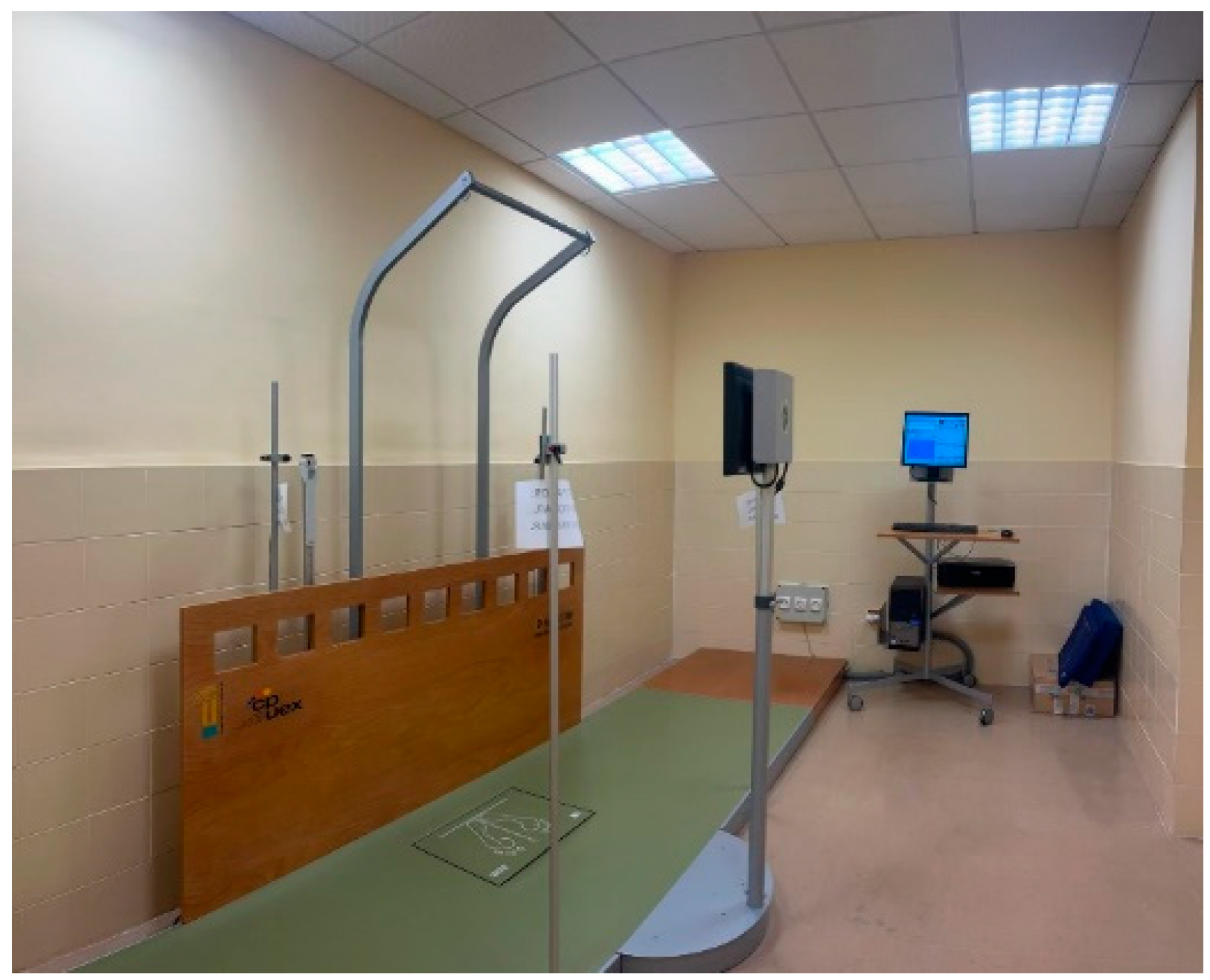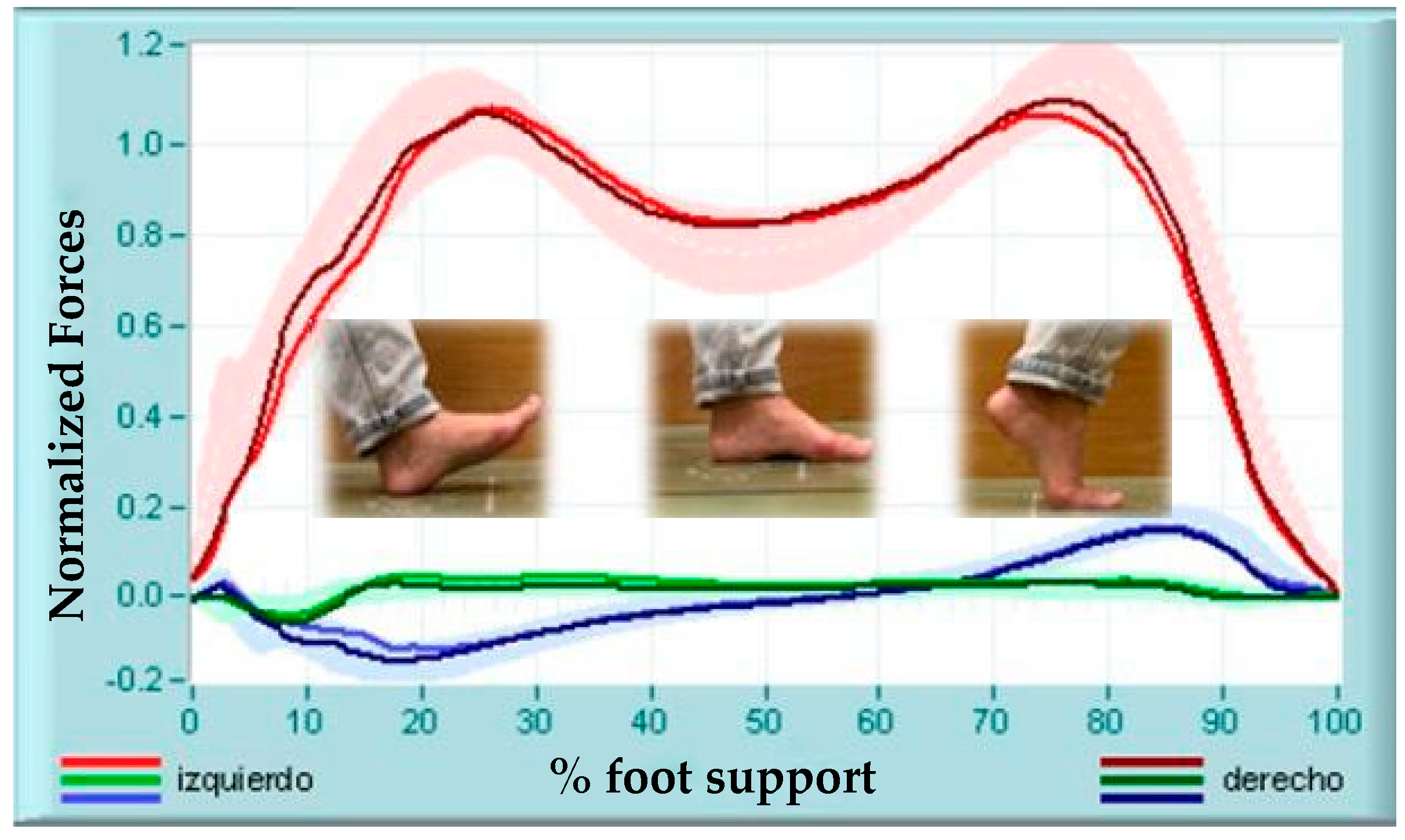Effects of Sports Shoe Drop on Walking Biomechanics: A Cross-Sectional Observational Dynamometric Study
Abstract
1. Introduction
2. Materials and Methods
2.1. Study Design
2.2. Sample
2.3. Data Collection Protocol
2.4. Statistical Analysis
3. Results
4. Discussion
5. Limitations
6. Conclusions
Author Contributions
Funding
Institutional Review Board Statement
Informed Consent Statement
Data Availability Statement
Conflicts of Interest
References
- Hurtado Padilla, A. Uso de la baropodometría. Ortho-Tips 2006, 2, 255–261. [Google Scholar]
- Roberts, M.; Mongeon, D.; Prince, F. Biomechanical parameters for gait analysis: A systematic review of healthy human gait. Phys. Ther. Rehabil. 2017, 4, 6. [Google Scholar] [CrossRef]
- Moody, D.; Hunter, I.; Ridge, S.; William Myrer, J. Comparison of Varying Heel to Toe Differences and Cushion to Barefoot Running in Novice Minimalist Runners. Int. J. Exerc. Sci. 2018, 11, 13–19. [Google Scholar] [CrossRef] [PubMed]
- Sun, X.; Lam, W.K.; Zhang, X.; Wang, J.; Fu, W. Systematic Review of the Role of Footwear Constructions in Running Biomechanics: Implications for Running-Related Injury and Performance. J. Sports Sci. Med. 2020, 19, 20–37. [Google Scholar] [PubMed]
- Gijón Nogueron, G. Factores del calzado deportico de carrera que influyen en la práctica deportiva: Revisión sistemática. Arch. Med. Deporte. 2014, 31, 105–110. [Google Scholar]
- Nicolas-Peyrot, M.A.; Lescure, Y.; Perrin, E.; Martinez-Rico, M.; Travouillon, C.; Gijon-Nogueron, G.; Lopezosa-Reca, E. Optimizing Running Mechanics, Effects of Cadence, Footwear, and Orthoses on Force Distribution: A Quasi-Experimental Study. J. Funct. Morphol. Kinesiol. 2025, 10, 89. [Google Scholar] [CrossRef]
- Besson, T.; Morio, C.; Millet, G.Y.; Rossi, J. Influence of shoe drop on running kinematics and kinetics in female runners. Eur. J. Sport Sci. 2019, 19, 1320–1327. [Google Scholar] [CrossRef]
- Quan, W.; Gao, L.; Xu, D.; Zhou, H.; Korim, T.; Shao, S.; Baker, J.S.; Gu, Y. Simulation of Lower Limb Muscle Activation Using Running Shoes with Different Heel-to-Toe Drops Using Opensim. Healthcare 2023, 11, 1243. [Google Scholar] [CrossRef]
- Chen, Y.; Li, J.X.; Wang, L. Influences of heel height on human postural stability and functional mobility between inexperienced and experienced high heel shoe wearers. PeerJ 2020, 8, e10239. [Google Scholar] [CrossRef] [PubMed]
- Wan, F.K.W.; Yick, K.L.; Yu, W.W.M. Effects of heel height and high-heel experience on foot stability during quiet standing. Gait Posture 2019, 68, 252–257. [Google Scholar] [CrossRef]
- Sánchez Lacuesta, J.; Comín, M.; Prat, J.; Soler, C.; Dejoz, R.; Peris, J.L.; Hoyos, J.V.; Vera, P. Nueva plataforma dinamométrica para el análisis y valoración del rendimiento deportivo. Biomecánica 1993, 1, 51–52. [Google Scholar] [CrossRef]
- Sánchez Lacuesta, J.J.; Prat Pastor, J.M.; Hoyos Fuentes, J.V.; Viosca Herrero, E.; Soler Gracia, C.; Comín Clavijo, M.; Lafuente Jorge, R.; Corté i Fabregat, A.; Vera Luna, P. Biomecánica de la Marcha Humana Normal y Patológica; Instituto de Biomecánica de Valencia: Valencia, Spain, 1999. [Google Scholar]
- Halliday, D.; Resnick, R.; Walker, J. Fundamentals of Physics; Wiley: Hoboken, NJ, USA, 2013; Volume 10. [Google Scholar]
- Li, X.; Lu, Z.; Sun, D.; Xuan, R.; Zheng, Z.; Gu, Y. The Influence of a Shoe’s Heel-Toe Drop on Gait Parameters during the Third Trimester of Pregnancy. Bioengineering 2022, 9, 241. [Google Scholar] [CrossRef] [PubMed]
- Jiang, L.; Qu, F.; Yang, Z.; Chen, X.; Gao, X.; Sun, Q.; Huo, B. Heel-to-toe drop effects on biomechanical and muscle synergy responses during uphill walking. Front. Bioeng. Biotechnol. 2024, 12, 1385264. [Google Scholar] [CrossRef] [PubMed]
- Zhang, M.; Shi, H.; Liu, H.; Zhou, X. Biomechanical analysis of running in shoes with different heel-to-toe drops. Appl. Sci. 2021, 11, 12144. [Google Scholar] [CrossRef]
- Yu, P.; He, Y.; Gu, Y.; Liu, Y.; Xuan, R.; Fernandez, J. Acute Effects of Heel-to-Toe Drop and Speed on Running Biomechanics and Strike Pattern in Male Recreational Runners: Application of Statistical Nonparametric Mapping in Lower Limb Biomechanics. Front. Bioeng. Biotechnol. 2022, 9, 821530. [Google Scholar] [CrossRef]
- Sánchez-Ramírez, C.; Ramsey, C.; Palma-Oyarce, V.; Herrera-Hernández, E.; Aedo-Muñoz, E. Heel-to-toe drop of running shoes: A systematic review of its biomechanical effects. Footwear Sci. 2023, 15, 77–101. [Google Scholar] [CrossRef]
- Bus, S.A.; de Lange, A. A comparison of the 1-step, 2-step, and 3-step protocols for obtaining barefoot plantar pressure data in the diabetic neuropathic foot. Clin. Biomech. 2005, 20, 892–899. [Google Scholar] [CrossRef]
- Peters, M. Footedness: Asymmetries in Foot Preference and Skill and Neuropsychological Assessment of Foot Movement. Psychol. Bull. 1988, 103, 179. [Google Scholar] [CrossRef]
- Griffin, M.P.; Olney, S.J.; McBride, I.D. Role of symmetry in gait performance of stroke subjects with hemiplegia. Gait Fosture 1995, 3, 132–142. [Google Scholar] [CrossRef]
- Hellige, J. Hemispheric Asymmetry: What’s Right and What’s Left, 3rd ed.; Stephen, M., Ed.; Harvard University Press: Cambridge, MA, USA, 2001. [Google Scholar]
- Oberg, T.; Karsznia, A.; Oberg, K. Basic gait parameters: Reference data for normal subjects, 10–79 years of age. J. Rehabil. Res. Dev. 1993, 30, 210–223. [Google Scholar]
- Al-Obaidi, S.; Wall, J.C.; Al-Yaqoub, A.; Al-Ghanim, M. Basic gait parameters: A comparison of reference data for normal subjects 20 to 29 years of age from Kuwait and Scandinavia. J. Rehabil. Res. Dev. 2003, 40, 361–366. [Google Scholar] [CrossRef]
- Bohannon, R.W.; Williams Andrews, A. Normal walking speed: A descriptive meta-analysis. Physiotherapy 2011, 97, 182–189. [Google Scholar] [CrossRef]
- Seidler, R.D.; Bernard, J.A.; Burutolu, T.B.; Fling, B.W.; Gordon, M.T.; Gwin, J.T.; Kwak, Y.; Lipps, D.B. Motor control and aging: Links to age-related brain structural, functional, and biochemical effects. Neurosci. Biobehav. Rev. 2010, 34, 721–733. [Google Scholar] [CrossRef]
- Morrison, S.; Colberg, S.R.; Parson, H.K.; Neumann, S.; Handel, R.; Vinik, E.J.; Paulson, J.; Vinik, A.I. Walking-Induced Fatigue Leads to Increased Falls Risk in Older Adults. J. Am. Med. Dir. Assoc. 2016, 17, 402–409. [Google Scholar] [CrossRef]
- Lieberman, D.E.; Venkadesan, M.; Werbel, W.A.; Daoud, A.I.; Dandrea, S.; Davis, I.S.; Mang’eNi, R.O.; Pitsiladis, Y. Foot strike patterns and collision forces in habitually barefoot versus shod runners. Nature 2010, 463, 531–535. [Google Scholar] [CrossRef] [PubMed]
- Bonacci, J.; Saunders, P.U.; Hicks, A.; Rantalainen, T.; Vicenzino, B.T.; Spratford, W. Running in a minimalist and lightweight shoe is not the same as running barefoot: A biomechanical study. Br. J. Sports Med. 2013, 47, 387–392. [Google Scholar] [CrossRef] [PubMed]
- Hall, J.P.L.; Barton, C.; Jones, P.R.; Morrissey, D. The biomechanical differences between barefoot and shod distance running: A systematic review and preliminary meta-analysis. Sports Med. 2013, 43, 1335–1353. [Google Scholar] [CrossRef]
- Altman, A.R.; Davis, I.S. Barefoot Running: Biomechanics and Implications for Running Injuries. Curr. Sports Med. Rep. 2012, 11, 244–250. [Google Scholar] [CrossRef]
- Squadrone, R.; Rodano, R.; Hamill, J.; Preatoni, E. Acute effect of different minimalist shoes on foot strike pattern and kinematics in rearfoot strikers during running. J. Sports Sci. 2015, 33, 1196–1204. [Google Scholar] [CrossRef]
- Tam, N.; Prins, D.; Divekar, N.V.; Lamberts, R.P. Biomechanical analysis of gait waveform data: Exploring differences between shod and barefoot running in habitually shod runners. Gait Posture 2017, 58, 274–279. [Google Scholar] [CrossRef] [PubMed]
- Ramírez González, S.; Rodríguez Guerra, D.; Rodríguez Labrada, R. Evaluación de la marcha en pacientes con ataxia espinocerebelosa tipo 2: Fundamentos teóricos. Olimpia 2021, 18, 1–9. [Google Scholar]
- Nuñez-Samper, M.; Llanos Alcázar, L.F. Biomecánica, Medicina Y Cirugía Del Pie; Masson: Barcelona, Spain, 2000. [Google Scholar]
- Lafuente, R.; Doñate, J.J.; Poveda, R.; García, A.; Soler, C.; Belda, J.M.; Sánchez Lacuesta, J.; Prat, J. Valoración evolutiva de fracturas de calcáneo mediante el análisis biomecánico de la marcha. Análisis de resultados. Mapfre Med. 2002, 13, 275–283. [Google Scholar]
- Lelièvre, J.L.J. Patología Del Pie; Masson: Barcelona, Spain, 1993. [Google Scholar]
- Riggs, B.L.; Melton, L.J.; Robb, R.A.; Camp, J.J.; Atkinson, E.J.; Peterson, J.M.; Rouleau, P.A.; McCollough, C.H.; Bouxsein, M.L.; Khosla, S. Population-based study of age and sex differences in bone volumetric density, size, geometry, and structure at different skeletal sites. J. Bone Miner. Res. 2004, 19, 1945–1954. [Google Scholar] [CrossRef] [PubMed]
- Tórtora Gerard, J.; Derrickson Bryan, H. Principios De Anatomía Y Fisiología, 15th ed.; Editorial Médica Panamericana: Madrid, Spain, 2018. [Google Scholar]
- Velez Vázquez, T.; Carbonero López, P.; del Baño Aledo, M.E. Sonographic study of muscular architecture of lower limb musculature: Gender and age variability. Fisioterapia 2022, 44, 6–14. [Google Scholar] [CrossRef]
- Alvarez-Nemegyei, J.; Pacheco-Pantoja, E.; González-Salazar, M.; López-Villanueva, R.F.; May-Kim, S.; Martínez-Vargas, L.; Quintal-Gutiérrez, D. Asociación entre sobrepeso/obesidad y estado clínico en artritis reumatoide. Reumatol. Clin. 2020, 16, 462–467. [Google Scholar] [CrossRef] [PubMed]




| p-Value | 0 mm | 5 mm | 10 mm | ||||
|---|---|---|---|---|---|---|---|
| Mean | SD | Mean | SD | Mean | SD | ||
| Speed (m/s) | 0.725 2 | 1.19 | 0.09 | 1.19 | 0.09 | 1.18 | 0.08 |
| Stance time (s) | 0.013 2 | 0.73 | 0.06 | 0.74 | 0.05 | 0.74 | 0.05 |
| Braking force (N) | 0.010 1 | 107.2 | 29.0 | 109.1 | 26.2 | 110.6 | 29.2 |
| Propulsion force (N) | 0.559 2 | 128.0 | 31.8 | 128.6 | 31.4 | 138.4 | 117.9 |
| Take-off force (N) | <0.001 1 | 763.3 | 146.6 | 771.5 | 148.1 | 774.7 | 148.7 |
| Swing force (N) | 0.002 2 | 551.3 | 120.8 | 549.7 | 121.1 | 543.8 | 119.0 |
| p-Value | Drop | |||
|---|---|---|---|---|
| 0–5 mm | 5–10 mm | 0–10 mm | ||
| Speed (m/s) | 0.725 2 | - | - | - |
| Stance time (s) | 0.013 2 | 0.139 | >0.999 | 0.015 |
| Braking force (N) | 0.010 1 | 0.161 | 0.241 | 0.010 |
| Propulsion force (N) | 0.559 2 | - | - | - |
| Take-off force (N) | <0.001 1 | <0.001 | 0.143 | <0.001 |
| Swing force (N) | 0.002 2 | 0.150 | 0.350 | 0.001 |
| Drop (mm) | Men | Women | ||
|---|---|---|---|---|
| Mean | Mean | p-Value | ||
| Speed (m/s) | 0 | 1.19 | 1.18 | 0.585 2 |
| 5 | 1.19 | 1.18 | 0.560 1 | |
| 10 | 1.19 | 1.18 | 0.678 1 | |
| Stance time (s) | 0 | 0.74 | 0.73 | 0.047 2 |
| 5 | 0.75 | 0.73 | 0.013 1 | |
| 10 | 0.75 | 0.73 | 0.001 1 | |
| Braking force (N) | 0 | 112.7 | 102.0 | 0.046 1 |
| 5 | 114.4 | 104.2 | 0.034 1 | |
| 10 | 118.1 | 103.7 | 0.007 1 | |
| Propulsion force (N) | 0 | 136.3 | 120.3 | 0.004 2 |
| 5 | 137.0 | 120.8 | 0.003 2 | |
| 10 | 134.6 | 141.8 | 0.031 2 | |
| Take-off force (N) | 0 | 821.9 | 709.4 | <0.001 2 |
| 5 | 833.7 | 714.5 | <0.001 2 | |
| 10 | 835.8 | 718.6 | <0.001 2 | |
| Swing force (N) | 0 | 610.0 | 497.5 | <0.001 2 |
| 5 | 605.0 | 498.8 | <0.001 2 | |
| 10 | 600.1 | 492.1 | <0.001 2 |
| Variables | Correlation Coefficient | ||
|---|---|---|---|
| Drop | |||
| 0 mm | 5 mm | 10 mm | |
| Braking force (N) | 0.677 ** | 0.676 ** | 0.733 ** |
| Propulsion force (N) | 0.742 ** | 0.759 ** | 0.771 ** |
| Take-off force (N) | 0.809 ** | 0.804 ** | 0.812 ** |
| Swing force (N) | 0.780 ** | 0.778 ** | 0.771 ** |
Disclaimer/Publisher’s Note: The statements, opinions and data contained in all publications are solely those of the individual author(s) and contributor(s) and not of MDPI and/or the editor(s). MDPI and/or the editor(s) disclaim responsibility for any injury to people or property resulting from any ideas, methods, instructions or products referred to in the content. |
© 2025 by the authors. Licensee MDPI, Basel, Switzerland. This article is an open access article distributed under the terms and conditions of the Creative Commons Attribution (CC BY) license (https://creativecommons.org/licenses/by/4.0/).
Share and Cite
Fragua-Blanca, R.; Tovaruela-Carrión, N.; Cobos-Moreno, P.; Tena-León, M.J.; Escamilla-Martínez, E. Effects of Sports Shoe Drop on Walking Biomechanics: A Cross-Sectional Observational Dynamometric Study. Appl. Sci. 2025, 15, 10515. https://doi.org/10.3390/app151910515
Fragua-Blanca R, Tovaruela-Carrión N, Cobos-Moreno P, Tena-León MJ, Escamilla-Martínez E. Effects of Sports Shoe Drop on Walking Biomechanics: A Cross-Sectional Observational Dynamometric Study. Applied Sciences. 2025; 15(19):10515. https://doi.org/10.3390/app151910515
Chicago/Turabian StyleFragua-Blanca, Raquel, Natalia Tovaruela-Carrión, Paula Cobos-Moreno, Manuel Jesús Tena-León, and Elena Escamilla-Martínez. 2025. "Effects of Sports Shoe Drop on Walking Biomechanics: A Cross-Sectional Observational Dynamometric Study" Applied Sciences 15, no. 19: 10515. https://doi.org/10.3390/app151910515
APA StyleFragua-Blanca, R., Tovaruela-Carrión, N., Cobos-Moreno, P., Tena-León, M. J., & Escamilla-Martínez, E. (2025). Effects of Sports Shoe Drop on Walking Biomechanics: A Cross-Sectional Observational Dynamometric Study. Applied Sciences, 15(19), 10515. https://doi.org/10.3390/app151910515







